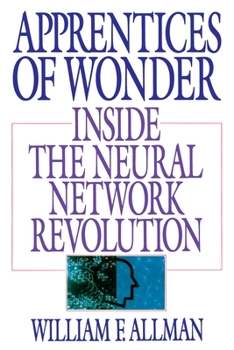Apprentices of Wonder: Inside the Neural Network Revolution
Select Format
Select Condition 
Book Overview
"If you want to understand the latest scientific thinking about the relations between mind and brain, meet Allman's Apprentices of Wonder."--Howard Gardner, author of The Mind's New Science: A History of Cognitive Revolution In the vein of The Soul of a New Machine comes this accessible book on the scientists who are creating startling theories of how the mind works as they forge a kind of artificial intelligence called neural networks--or, the first thinking machines. "This snappy introduction to the possibilities of the new sciences of connectionism will inform readers why mahy brain scientists are excited--and why the skeptics remain to be persuaded."--Pamela McCorduck, coauthor, with Mitchell Feigenbaum, of The Fifth Generation and author of Machines Who Think and The Universal Machine
Format:Paperback
Language:English
ISBN:0553349465
ISBN13:9780553349467
Release Date:August 1990
Publisher:Bantam
Length:228 Pages
Weight:0.80 lbs.
Dimensions:0.6" x 6.7" x 8.5"
Customer Reviews
1 rating
An accountant who plays jazz for a hobby??
Published by Thriftbooks.com User , 20 years ago
I've just finished reading the book "Apprentices of wonder - Inside the Neural Network Revolution", by William F. Allman. It was an old book, published in 1989. This book tells us stories about those pioneers in neural network research and development. The most interesting part of the book is about the fight between symbolic AI and connectionism AI. In the end, the author concluded that neither side won and the future of AI could be some form of the combination of these two. I totally agree with the author on this. In the book, in order to show that day-to-day human reasoning is not symbolic (totally rely on logic rules), the author gave us a very interesting study by psychologists Daniel Kahneman, Paul Slovic, and Amos Tversky. In this study, subjects were given a short description of a person and then asked to guess which professions and hobbies the person was most likely to have. Here we have: Russ is 34 years old. He is intelligent, but unimaginative, compulsive, and generally lifeless. In school, he was strong in mathematics but weak in social studies and humanities. Please rank in oder the following statements by their probability, using 1 for the most probable and 8 for the least probable. Russ is a physician who plays poker for a hobby. Russ is an architect. Russ is an accountant. Russ plays jazz for a hobby. Russ surfs for a hobby. Russ is a writer. Russ is an accountant who plays jazz for a hobby. Russ climbs mountains for a hobby. The results of the study? Most people, quite reasonably, ranked "Russ is an accountant" as most probable. They also ranked "Russ plays jazz for a hobby" as very unlikely. However, most people also said the probability that "Russ is an accountant who plays jazz for a hobby" is higher than the probability that "Russ plays jazz for a hobby." But this violates the laws of probability! It is impossible for a statement combining two unrelated (even related - yuz) elements to be more probable than either element alone. The author claimed that even those students trained in probability and decision science made the same mistake! The current probability theory defines that P(AB)=P(A)P(B|A)=P(B)P(A|B), since P(X) is never bigger than 1, P(AB) will never be bigger than P(A) or P(B). This is really interesting, we are not only having born optical illusions, we also have born mental illusions! This explained a lot about my stupid decisions made in the past:-) What is truly wrong?? Our common-sense neural network or the symbolic probability theory?






